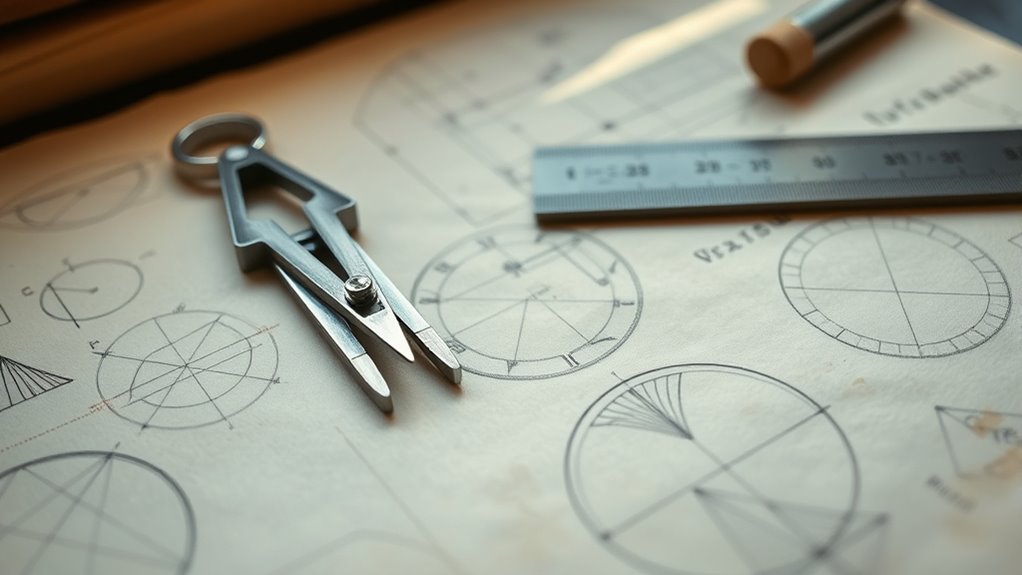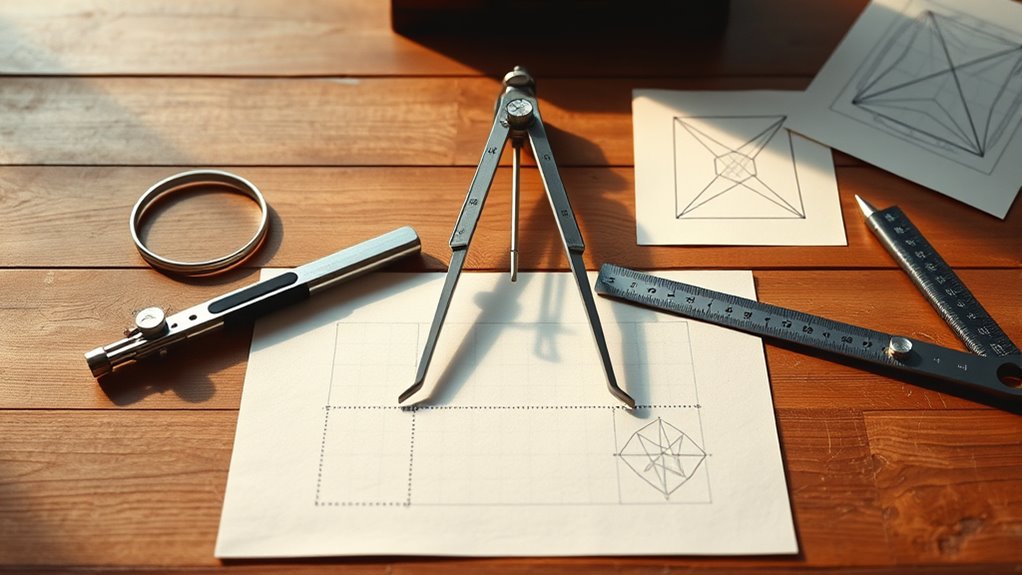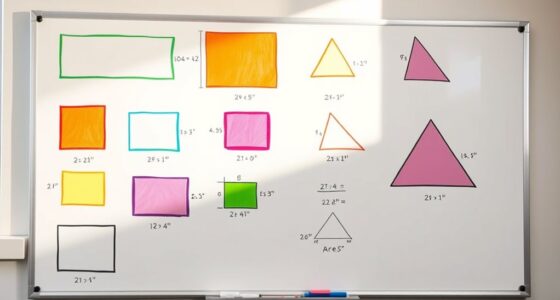With compass and straightedge, you can create impressive geometric figures like perfect circles, bisect angles, and construct regular polygons such as pentagons within a circle. You’ll also learn to transfer measurements accurately and build perpendicular bisectors or tangent lines. These classical constructions showcase human ingenuity and patience, turning simple tools into precise geometric masterpieces. Keep exploring, and you’ll discover how to perform these neat tricks step-by-step and reveal the magic behind timeless geometry.
Key Takeaways
- Learn to construct equilateral triangles, perpendicular bisectors, and angle bisectors using only compass and straightedge.
- Practice creating inscribed regular polygons, like pentagons and hexagons, within a circle.
- Discover how to bisect angles and segments accurately to build complex geometric figures.
- Master step-by-step techniques for constructing parallel lines, perpendiculars, and intersections.
- Explore classic constructions that demonstrate the elegance and precision achievable with simple tools.

Have you ever wondered how ancient mathematicians could construct perfect geometric figures using only a compass and straightedge? These methods, rooted in centuries of mathematical tradition, allowed them to create what are now considered some of the most impressive geometric marvels. The process was far from simple, often presenting formidable construction challenges that tested their understanding of fundamental principles. Yet, through ingenuity and precise techniques, they achieved stunning accuracy, leaving behind a legacy of elegant diagrams and theorems.
Ancient mathematicians mastered perfect figures with simple tools through ingenuity and precise constructions.
When you attempt classic constructions, you’re engaging with the same challenges faced by those ancient geometers. For example, constructing an equilateral triangle with just a compass and straightedge seems straightforward at first, but ensuring all sides are exactly equal demands meticulous precision. The challenge lies in transferring distances accurately, especially when the figures involve intersecting circles or complex angles. These construction challenges aren’t just about drawing lines; they require a deep understanding of how circles and lines interact, and how to leverage their properties to achieve the desired figures.
One of the most famous geometric marvels is the construction of a regular pentagon inscribed within a circle. It looks simple but involves intricate steps that demand exactness. You start by drawing a circle, then carefully mark off points along its circumference using a compass, ensuring each point is evenly spaced. The challenge arises in bisecting angles and verifying equal lengths without tools beyond your compass and straightedge. Achieving this requires patience and careful measurement, highlighting the difficulty of perfect constructions. These challenges weren’t just academic exercises; they showcased human ingenuity in overcoming the limitations of simple tools to produce perfect forms.
Similarly, constructing the perpendicular bisector of a segment or the angle bisector seems straightforward but involves precise steps to ensure accuracy. These foundational constructions serve as building blocks for more complex figures, and mastering them involves overcoming construction challenges that sharpen your geometric intuition. Every step must be executed with care, as small errors can compound, preventing the figure from being truly perfect.
In essence, working through these classic geometric constructions allows you to appreciate the remarkable skill ancient mathematicians developed. Despite their limited tools, they could produce figures of extraordinary precision, transforming simple circles and lines into geometric marvels. These construction challenges continue to inspire and educate, reminding us that with patience, precision, and understanding, even the most complex shapes can be built with just a compass and straightedge. It’s a tribute to the timeless beauty and logical elegance of classical geometry.
Frequently Asked Questions
Can Compass and Straightedge Constructions Solve All Geometric Problems?
You might think compass and straightedge constructions can solve all geometric problems, but there are limitations. Some tasks, like squaring the circle or doubling the cube, are impossible with these tools alone due to mathematical impossibilities proven long ago. While they’re powerful for many classic constructions, understanding their limitations helps you recognize when a problem surpasses what’s achievable with just compass and straightedge.
What Are the Historical Origins of Classical Geometric Constructions?
Did you know that classical geometric constructions date back over 2,000 years? You’ll find their roots in ancient Greek origins, where early mathematicians like Euclid and Archimedes laid the foundation for precise compass and straightedge techniques. These classical mathematicians explored fundamental properties of shapes and lines, creating methods still taught today. Their work revolutionized geometry and influenced centuries of mathematical thought, making these constructions timeless tools in understanding space and form.
Are There Modern Tools That Enhance Traditional Compass and Straightedge Techniques?
You can now enhance traditional compass and straightedge techniques with modern tools like digital tools and educational apps. These resources make learning and practicing geometric constructions easier and more interactive. You can visualize complex figures, get instant feedback, and experiment freely without physical instruments. Using these modern tools, you deepen your understanding of geometric principles while enjoying a more engaging and accessible experience compared to traditional methods.
How Accurate Are Manual Compass and Straightedge Constructions?
Imagine drawing with a gentle hand, but even then, your compass and straightedge have their limits. Your constructions are subject to precision limitations and error sources like slight hand movements and tool quality. While skilled hands can achieve impressive accuracy, small deviations can occur. So, your constructions are not perfectly precise, but with care, they can be remarkably close, making them invaluable for many geometric tasks.
Can These Constructions Be Applied to Real-World Engineering Problems?
You wonder if these constructions apply to practical engineering, and the answer is yes, but with limitations. While compass and straightedge techniques are precise for theoretical problems, real-world engineering faces construction limitations like material imperfections and measurement errors. You can use these methods for initial sketches and conceptual designs, but for detailed engineering, you’ll need more accurate tools and methods to guarantee safety and precision in your projects.
Conclusion
As you master these classic constructions, you’re wielding a magic wand that transforms simple tools into gateways of discovery. Like a skilled sorcerer, you turn points, lines, and circles into wondrous creations, revealing the universe’s hidden secrets. Remember, with patience and practice, you’re not just drawing shapes—you’re revealing the timeless enchantment of geometry’s ancient spellbook. Keep experimenting, and let your curiosity be the compass guiding you through this enthralling mathematical voyage.









